|
|
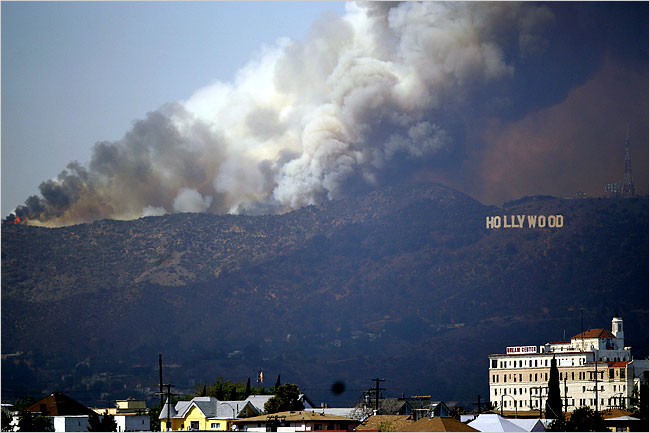 [Image: Photo by Kim Johnson Flodin/Associated Press, via the New York Times]. [Image: Photo by Kim Johnson Flodin/Associated Press, via the New York Times].Not being a local news follower, I found myself sitting outside yesterday afternoon in Los Angeles, beneath a huge brown cloud that seemed to hover there, more or less stationary, above the parking lot beside me. The cloud was totally alone, surrounded on all sides by perfectly blue sky, as if a thunderstorm had rolled in – only to change its mind and drift off, leaving part of itself behind, atmospherically orphaned in the sunlight. After all, there was no rain. The cloud didn't appear to be moving. I began expecting an earthquake. "Is there a fire or something?" I asked a guy wearing sunglasses as he walked past me on the sidewalk – but it occurred to me, absurdly, even as I heard myself asking him the question, that perhaps the cloud would be impossible to see through his sunglasses: its color would be visually filtered out by the glass's tint and so he wouldn't even know what I was talking about. Instead, he just nodded and said, "Uh huh," walking off past Radio Shack. Still detached from the local news cycle at that point, and beginning to notice that not a single other person was looking up into the sky at what seemed, at least to me, to be a very obvious and possibly threatening brown cloud, I decided that people here really must be so over-trustful of the world that even a menacing, oily blur hovering above their heads could simply be perceptually filed away as some weird but harmless fluke: it'll go away – it won't be here tomorrow – and you can therefore just forget it ever happened... Don't think about it and it won't harm you. Which is when I remembered something called the "airborne toxic event" from Don DeLillo's novel White Noise. About a third of the way through that book, there is a train derailment somewhere outside a small American college town. The accident releases a toxic cloud into the sky: "the smoke was plainly visible," we read, "a heavy black mass hanging in the air beyond the river, more or less shapeless." One of the characters says it resembles "a shapeless growing thing. A dark black breathing thing of smoke." Families close to the accident are soon asked to evacuate – "Abandon all domiciles," an amplified voice calls out, broadcast from a truck that drives through the cul-de-sacs – while "medical problems" that might develop upon "personal contact with the airborne toxic event" are discussed on the radio. One of these problems is apparently déjà vu. The source of the cloud, meanwhile, is being buried by snow machines, in the weird hope that this will thermo-chemically contain its spread; and so an artificial winter begins to erupt as rogue flakes blow on contaminated winds through the suburbs. Etc. etc. It's all very ironic and surreal. At one point, though, the drifting cloud becomes an all-out military spectacle: A few minutes later, back on the road, we saw a remarkable and startling sight. It appeared in the sky ahead of us and to the left, prompting us to lower ourselves in our seats, bend our heads for a clearer view, exclaim to each other in half finished phrases. It was the black billowing cloud, the airborne toxic event, lighted by the clear beams of seven army helicopters. They were tracking its windborne movement, keeping it in view. In every car, heads shifted, drivers blew their horns to alert others, faces appeared in side windows, expressions set in tones of outlandish wonderment.
The enormous dark mass moved like some death ship in a Norse legend, escorted across the night by armored creatures with spiral wings. We weren't sure how to react. To find out what happens next, both to the cloud and to the people watching it, you'll just have to read the book; but, returning to a bench in Los Angeles yesterday – yes, there is one – on top of which I sat, looking up at an oily blur that seemed oddly rooted in place there above a parking lot, with no one else visibly concerned, no one else appearing to wonder what on earth it was that had come to visit us that day, there in the atmosphere, shadowing us, perhaps some strange and void-like inversion set to suck away the very air we breathed, I was sad to learn that the whole thing was just the downwind result of a fire in the Hollywood Hills – an event I had otherwise managed to miss seeing entirely. 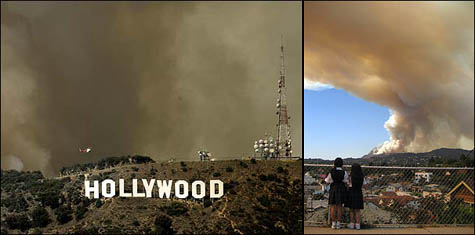 [Images: Via the BBC]. [Images: Via the BBC].So much for the sublime or the inexplicable or the mysterious. I went back to reading, and the cloud blew away.
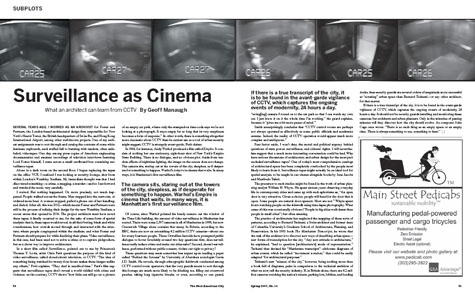 [Image: A page-spread from The Next American City]. [Image: A page-spread from The Next American City].If you're looking for something to read outside the internet, I've got a short article in this month's issue of The Next American City about the use of video surveillance – CCTV – as a new, cinematic form of urban analysis. Citing Andy Warhol, John Cage, Bernard Tschumi, William Whyte's "film analyses of corporate plazas, urban streets, parks and other open spaces," Chris Petit, and a variety of other sources, the article makes the claim that 24-hour surveillance of urban space is a tool being used by the wrong industry: it shouldn't be private security firms installing these cameras in the name of public safety – but architects and urban planners, putting them up for the purpose of spatial research... In any case, if you see a copy of the magazine lying around be sure to pick it up. Alternatively, I'll be giving away some free copies at next week's event in San Francisco – so let me know if you're looking for one.
Yesterday, via the BBC, BLDGBLOG explored the militarily controlled and organized instant city of Naypyidaw, new capital of Burma (aka Myanmar), a whole city built so that the Burmese dictatorship could move nearly 300 miles north from where the capital had originally been (Rangoon – aka Yangon). But what if they'd moved the capital – a mere two miles? Or one mile – or twenty-five feet? The entire imperial capital picks up... and moves eight feet to the southwest. Thirty-five centimeters. The buildings themselves aren't changed – though perhaps all the streets are renamed. Meanwhile, everything looks the same. Except... 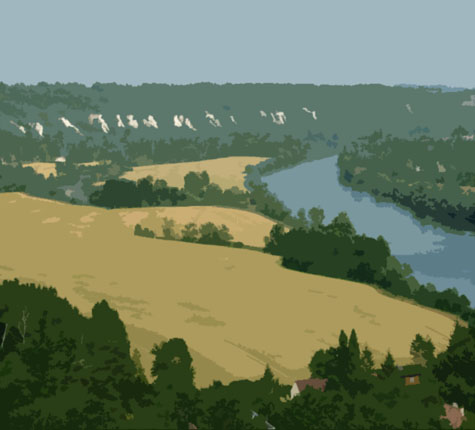 Or: as a child you went on holidays with your auntie to a small village in southern France, but now you're 63 years old and you haven't been there in half a century. So you hire a car and you drive down, alone, crossing the Millau Viaduct, to arrive in the same old village before sunset. But something doesn't feel right. For one thing, that view of the distant hills that you remember so vividly, from the picture window in your family cottage outside town, no longer even captures the hills; instead you stare blankly at the valley right next to them. How could that have happened...? And the front door no longer opens out to face the old oak tree. Worse, the nearby forest seems a whole lot closer to the edge of town, and several buildings are practically falling into the nearby river; that's impossible, you think: you used to play down there. Is your memory really that bad? You can't sleep at night. Do you have Alzheimer's Disease...? You toss and turn. Do you drink too much? You get up and look out the window, dehydrated. Or have you just been wrong about everything, all along? How sad. 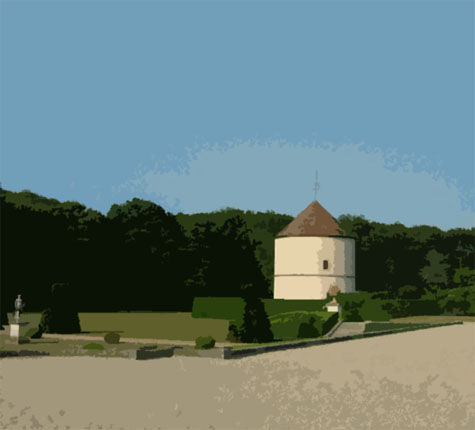 To bide the time before driving back north, you do some casual gardening out back, screwing around with a shovel and wondering why, as you tried to go back to find the past, everything fell out from beneath you – when you discover something: foundation stones. You clear away more dirt and stare. They match the outline of the family cottage. You dig a bit more, sweating – and, as some clouds pass over the sun, sending a chill down the back of your neck, you find that stupid plastic toy you buried as a 12-year old. You'd put it right beside the house – you remember that – you'd even been scolded for digging so close to your auntie's bedroom window – yet now here it is clear out in the middle of the yard. You drop the shovel. Small discrepancies like this suddenly stand out all over town: the well in the central plaza, for instance, is now inexplicably close to the old tavern – whereas it very definitely used to stand right out there in the open, catching sunshine. You used to read books there. You know what you're talking about. You don't have Alzheimer's Disease. The town has been moved.
The BBC reports that "Burma's military rulers have been showing off their new capital for the first time to the outside world." 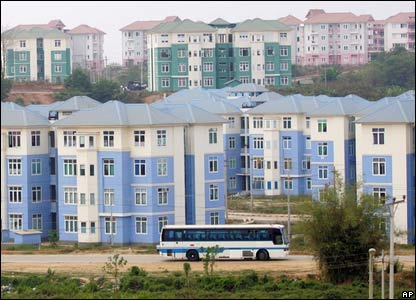 [Image: The new Burmese capital of Naypyidaw, photographed by the Associated Press; via the BBC]. [Image: The new Burmese capital of Naypyidaw, photographed by the Associated Press; via the BBC].This brand new city will be called Naypyidaw, or Abode of Kings, and it "is being built on a vast and extravagant scale in hundreds of square kilometres of tropical scrubland. Shining new buildings rise out of tropical scrub like a mirage, separated by miles of broad highways and boulevards." Even though the military now has "a fortress-like complex" on the east side of the city, "it is still not clear why the generals have moved here." Some analysts, the BBC explores elsewhere, have suggested that the move came about because "the country's hard-line military rulers were worried about foreign invasion, or wanted more control over ethnic minorities in the border regions, or were even following the advice of fortune tellers." However the plans were decided, rumors now suggest that there is "a maze of underground tunnels being built" – and the new city itself has been described "as the government's 'rat hole'." 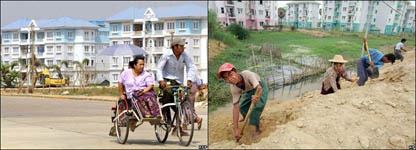 [Image: Courtesy of the Associated Press, via the BBC]. [Image: Courtesy of the Associated Press, via the BBC].But even if only on the most superficial level, Naypyidaw seems desolate, sterile, and utterly boring – and, if you believe Mike Davis, it is also the spatial end-result of the region's violent and decade-long "urban beautification" program, led by the Burmese military. In Planet of Slums – which Davis discussed last year in an interview with BLDGBLOG – we read: The most Orwellian "urban beautification" program in Asia in recent times, however, was undoubtedly the preparations for "Visit Myanmar Year 1996" undertaken by the heroin-financed Burmese military dictatorship in Rangoon and Mandalay. One-and-a-half million residents – an incredible 16 percent of the total urban population – were removed from their homes (frequently by state-sponsored arson) between 1989 and 1994 and shipped out to hastily constructed bamboo-and-hatch huts in the urban periphery, now creepily renamed the "New Fields." No one knew when their turn might come, and even the dead were evicted from the cemeteries. Davis then quotes a scholar named Monique Skidmore, who writes that "whole city blocks disappear in a matter of days" – like some militarized version of China Miéville's " Reports of Certain Events In London," in which whole streets appear and disappear, violently carving their way through the city. Skidmore continues: "Through the renaming, rebuilding, and relocating of familiar landmarks and the heavy presence of the army and weaponry, the military council imposes a new spatial configuration on Rangoon... suppressing potential democratic neighborhoods, demolishing the inner city, and creating new urban centers that immortalize the principle of authoritarianism." The result, she writes, is "a landscape glorifying the control and authoritarian vision of its leaders." 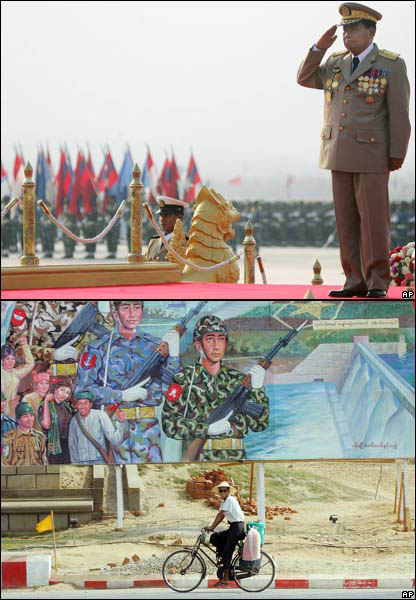 [Image: Courtesy of the Associated Press, via the BBC]. [Image: Courtesy of the Associated Press, via the BBC].The new capital town of Naypyidaw is just the logical extension of these spatial practices: urban design by police and military planners. (Despite its flaws, by the way, Planet of Slums really is worth reading – it's a short book and you could finish it in two or three long sessions).
I've just added two sketches by Mark Goerner to the film fest page; the images are also pictured here. I love this stuff! 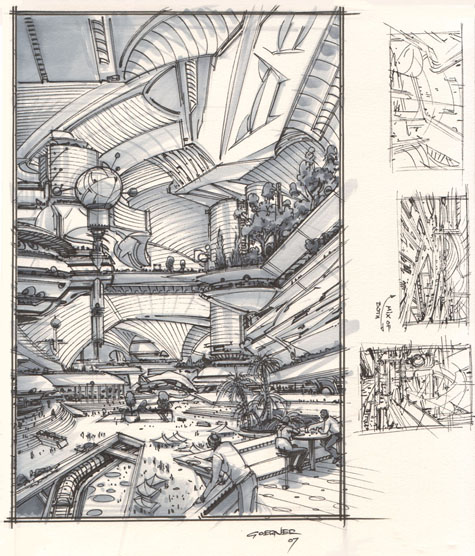 [Image: A sketch by Mark Goerner]. [Image: A sketch by Mark Goerner].You're looking, first, at Mark's vision of a future Tokyo, glancing down over the rim of a balcony into a massive hotel-like interior with its own train system and a kind of tent market laid out on the main floor (here's a much larger version to check out). 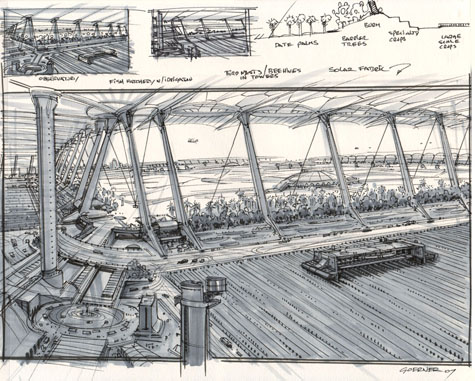 [Image: A sketch by Mark Goerner]. [Image: A sketch by Mark Goerner].Then you're looking at a speculative building for a future Sahara, complete with fish hatcheries, beehive towers, barrier trees, and a roof made of "solar fabric" (larger version also available). So I'll use this as a quick reminder to come out to the event on May 8th, and to bring a friend and some questions and listen to four guys talking about film and architecture.
I don't want the recent Ole Bouman interview to get buried under new posts, so let me highlight a few brief moments in the interview that I particularly like, and then encourage you to go read it in full. 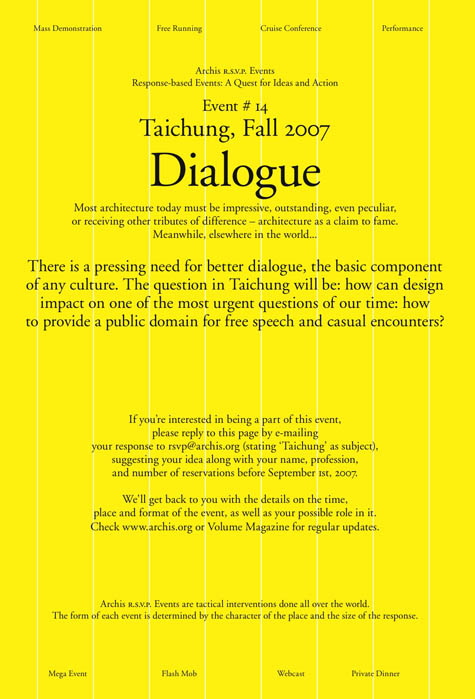 For instance, Bouman says: "if you think that applying urban form is the same as building a city, or even creating urban culture, then you make a very big mistake." He goes on to describe how "architecture culture" in the mid-1990s "was taken hostage by the politics of the spectacular." Even today, though, he says, "nothing has changed. There is still an incredible focus – not just among architects, but among clients – on an architecture that is strongest at first sight. The second sight or the third sight is not so important anymore." In the process, "large congregations of architecture" have come to replace real cities – a kind of illegitimate spatial surrogate – and these are the hollow landscapes within which many of us now find ourselves living. On the subject of post-conflict cities, then – or cities made hollow not by development but by war – Bouman says: Very often all the discourse that is left to those people in post-conflict cities is about everyday needs, or maybe some rebuilding of political institutions; but culture is always at the end of the story, at the end of the line. What we can do is provide them with discourse, give them a certain vitality, as we did in Ramallah once, in Bosnia once, in Vilnius once – and even as we did at the feet of the Statue of Liberty once. If a city is in trouble, sometimes it’s good to organize dialogue, regardless of the subject matter – dialogue as a goal in itself. Dialogue – and architecture, more broadly speaking – is thus about "reclaiming the public domain." That, of course, comes immediately after Bouman discusses China – which is perhaps my favorite part of the interview. There, Bouman says, and I'll quote him at great length: Bouman: It’s strange that China is seen as a new world by many Westerners, a land of opportunity, a place they all want to go... China is still seen as another world. You have to go there. You have to get yourself a portfolio in China. Or you have to start your office, or open a new headquarters there – so there is always the concept of over there, of otherness. I talk to Chinese colleagues, and Chinese businesspeople, and they sometimes openly admit that this persistence of otherness, this persistence of the idea that this is a country that is different from the West, that you can go to, or send your money to, is helping China to take over. To put it dramatically.
So, in terms of capital, for instance, if you just consider the fact that 15 years of boundless investment in China – hundreds of billions of dollars of investment in China, within a very Western paradigm of finding the best returns – is also, in the long-term, undermining the Western position. So, in a Western way of thinking, and from a capitalist point of view, investing in China may actually accomplish the opposite of what investors intended. These kind of paradoxes are hardly understood.
If China is launching a new rocket, or a new satellite, or testing a new space weapon system, suddenly people wake up – but there is this strange anomaly between China as the promised land and China as the latent rival, the opponent, the growing danger. Either people accept that China is becoming part of a larger global system of capital, and so they aren’t afraid to give it its own momentum wherever it goes, or whatever it takes – that is just the price you pay for growth. Or you say: we can no longer accept this – and this might be a moment that is not so far away anymore, a moment of regression or conservatism. Some governments will say that we can no longer go there, maybe, because we would not like to add to the power and culture of China. It’s still very fashionable to host Chinese festivals and to invite Chinese artists and to buy Chinese art – but the moment might not be so far away when we ask: why would we pay for China? If it reinforces or strengthens their power?
I feel sometimes that we are just a little bit away from the moment when this paradox, this anomaly, will erupt into a more existential question. What do we do? Do we keep adding to the strength of China? Or do we go back to this kind of Western chauvinism, or nationalism, and not allow architects, for instance, to work in China or to allow Western investors to invest in China?
I think, in the work of Rem Koolhaas, for instance, this anomaly is almost already on the surface. On the one hand there’s this admiration of the great architect with an incredible track record who goes to build in China, who creates a new monument, a kind of signal of what architecture can do, an incredible achievement. On the other hand, there is this latent, almost open criticism: what does this do for China? Are we giving away our assets to the enemy? I think in the whole discussion around the CCTV Building you see this tension between chauvinism and internationalism, between western interests and the interests of globalization in general, and many other dialectics in the debate being played out through that specific building. That’s why the building is so interesting. As a metaphor, it represents much more than just the fact that it is built for an institution of Chinese power by a powerful western architect; it also reveals something that has to do with the dynamics of our culture – and where architecture can do that, then architecture is gaining in legitimacy.  [Image: Ole Bouman, photographed by Cassander Eeftinck Schattenkerk]. [Image: Ole Bouman, photographed by Cassander Eeftinck Schattenkerk].In any case, if you get a chance, check out the rest of the interview.
I'll shamelessly point out that BLDGBLOG, Inhabitat, and Archinect's school blogs project were all written up in Monday's edition of the Wall Street Journal.  [Image: Bullish on Wall Street; image via]. [Image: Bullish on Wall Street; image via].About Inhabitat, we read: Jill Fehrenbacher, a graduate student at Columbia University's architecture program, created her group blog in 2005 to explore what seemed to be an untapped topic: sustainable architecture, which focuses on using recycled materials and otherwise protecting the environment. "I wanted to read something that had that focus, and couldn't find anything out there," Ms. Fehrenbacher says. "There are publications dedicated to design, and policy issues, but nothing about the overlap between the two." Recent posts cover a "disposable chandelier" made of plastic wine glasses, and the designs for towers in a park that are meant to be covered with vines. We also learn that Inhabitat "has as many as 20 contributors, but that only five write frequently"; indeed, Jill herself "edits all the posts in addition to contributing her own." Turning its attention to the Archinect school blogs, then, the Wall Street Journal reports: Paul Petrunia, a Web producer who helps architects develop sites for their projects, founded the Archinect school (!) as a resource for aspiring architecture students. The close-knit nature of the industry, he says, presents a challenge for people who want to know which programs are the best and which skills they should develop. So the school blogs help them out. Prospective students can thus "browse the blogs – which are indexed by region and school – to get an inside look at programs that interest them." Finally, reaching the very bottom of the column, as the bicep-flexing brokers of Wall Street chew clients' ears off over the phone and pop tabs of Alka-Seltzer, and as mortgages collapse in suburbs and commuter belt towns throughout the nation, the Wall Street Journal clears its throat and begins, timidly, as if unsure that this is really worth repeating to others: Geoff Manaugh says that there are architecture writers who are primarily concerned with buildings and others who are interested in anything architectural. His blog is definitely an example of the latter. Recent posts have covered a photograph of a "cosmic volcano" associated with star formation, a shantytown built on a frozen lake in Minnesota and the recent purchase on eBay of the window through which John F. Kennedy was assassinated. The Dow briefly rose upon the findings... In any case, I was happy to see the coverage. (Thanks to Jill and Paul for the tip!)
 [Image: Ole Bouman, photographed by Cassander Eeftinck Schattenkerk]. [Image: Ole Bouman, photographed by Cassander Eeftinck Schattenkerk].
In May 2005, Ole Bouman and Rem Koolhaas co-founded Volume. Volume was meant as both a magazine and a " global idea platform... dedicated to experimentation and the production of new forms of architectural discourse." The tenth issue of Volume was published last month.
On April 1, 2007, Ole Bouman will become Director of the Netherlands Architecture Institute in Rotterdam. As he explained in an NAI press release, that role will involve "draw[ing] inspiration from the major spatial challenges of our time."
In the following interview, Bouman talks to BLDGBLOG about some of these "spatial challenges," including the role of "agitation" in architecture; who the real audience for architectural journalism might be; the "politics of the spectacular"; unexpected possible side-effects of long-term investment in China; public space and dialogue in post-conflict cities; and the future of the Netherlands Architecture Institute.
• • •
BLDGBLOG: The new issue of Volume is themed around agitation . What exactly does that mean in the context of architecture?Ole Bouman: Agitation is, of course, a very general category. It’s also a cultural term that has strong political connotations. In terms of Volume, as a way of approaching architecture, I think it’s good to cover that theme, to explore agitation in the present state of affairs, and to challenge the accepted formats, the accepted language, the accepted procedures in architecture. It’s a way to expand the architectural imagination in a way. BLDGBLOG: You’ve said that part of this comes through asking why in architecture.Bouman: Well, I think it’s very important to acknowledge the necessity of asking why in general. In a culture where people, at a very early stage of their careers, are forced to stick to their subject – or to a specific role – there is, in my view, an extreme urgency to keep asking why. Why, in a way, is a very innocent question and a very childish question – but it is also a very important question. It doesn’t allow you to take things for granted in terms of the role you play in society, or the service you provide to society and things like that. It always brings you back to fundamental questions about your presence, your role, your possibilities – etc. etc. So it’s an extremely important question, and, I would hope, a very obvious question – but, unfortunately, it is not so common anymore. Posing it so explicitly – pushing forward this notion of why – is itself already a critical act. This is in contrast to presenting what you’re doing, how you are doing it, or – more gossipy – who is doing something. Who and what and how are, of course, very important questions, and there is a big market for those questions: everybody knows that you can make a lot of money presenting what has been done by other people. And there is a growing market now for information about the person behind the built work, the personality behind the building. But for why there is no natural market. So we are trying to create a momentum behind this spirit, to create a market for why. And if we find sufficient international readers who share this attitude – asking why wherever they go and whatever they do – then maybe this project is sustainable in the long term. But this is an experiment, and we don’t know yet where it will go. 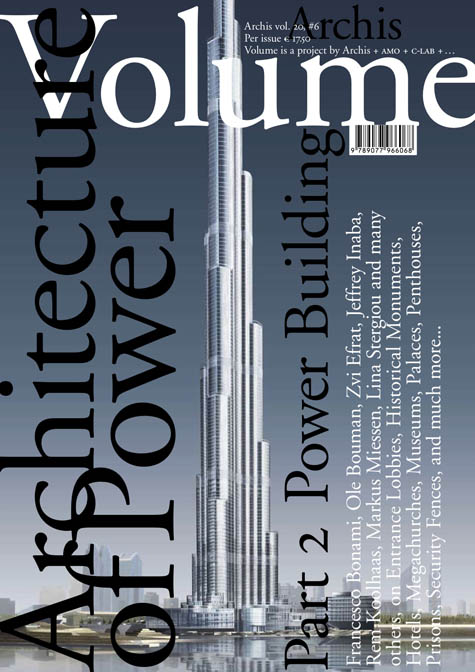 BLDGBLOG BLDGBLOG: In Volume #6 you refer to the idea that clients are a kind of “necessary evil.” But what’s interesting, in the context of architecture, is that magazines like Dwell and Metropolis are more popular than ever – which seems, at the very least, to indicate that clients read magazines, too . In other words, the people who buy and commission architecture also want to read about architecture. Perhaps, then, the declining popularity of non-mass market architectural criticism simply indicates that critics are not writing for clients anymore – for the people who actually purchase architecture. Instead, they are writing for other architects , and so of course architectural criticism appears to be in decline. Where would Volume fit in, here? Bouman: It is a good question. Of course, there are at least three different layers of clients. First of all, there are the people with money who want a program to be accommodated by an architectural work – in other words, a client in the traditional sense. But I don’t think that there is a sufficient market for a magazine that would address that specific group. There is also the client, in terms of the decision-maker. Maybe that person is not about to commission an architect to do something now, but they may ask an architect to do something in the future. And there are decision-makers throughout society – so this is a much larger group. If magazines can address this group of decision-makers specifically, then they already have a bigger reader base. But, of course, there is also a group of clients that thinks, maybe in a more metaphorical way, about architecture as a way of fulfilling their dreams or serving their interests, in both a material way and in a more idealistic sense. And if our readership is this larger group of people – a very mixed group – then you could say that we already do address clients as the people who ask questions to architects – not just ask for buildings from architects, but who ask architects to engage with these issues. They ask architects to address larger social issues, rather than just supply built stuff. This is a redefinition of architecture, from delivering an object to a definition of architecture that challenges certain issues within a larger cultural strategy. I think there could be a great dialogue between architects and this group of people. And this spirit and interpretation of the client is perhaps what we are addressing. Of course, the question comes up: is it still necessary to call this group clients and not just the public? But I think it is a nice way to put it: to see those people, this larger group of people engaged in cultural issues, as clients, who ask questions without an immediate budget, without pointing at a specific site, without asking you to accommodate a program. They ask general questions of architecture, and that helps us mobilize architecture beyond one specific purpose. BLDGBLOG: So we need a new, or different, kind of architect now, in addition to a new way of interacting with clients?Bouman: Yes – and that brings me to the role of the architect in responding to the client. This can no longer be the reactive way that most architects work with clients. In the first definition I gave of the client, the client is asking a question: Architect X or Architect Y, can you do something for me, because I need you? The output of architecture, in that sense, is very reactive. It can only be based on a program, a budget, a site, an existing location, etc. etc. – but there is always something coming first, before the architectural act. In the other description I gave of the client, there is more of a shared interest – a common interest – with architects addressing a cultural or political issue from the angle of architecture. So there is a dialogue between different people with a common curiosity, and that can evolve into a completely different output of the architectural discipline. It gives architects a new role, I think, in the long-term, and this may even give architecture its future legitimacy. If an art form or a scientific discipline, in the end, only boils down to performing a service for other people, then it’s very hard to find cultural legitimacy for that discipline. 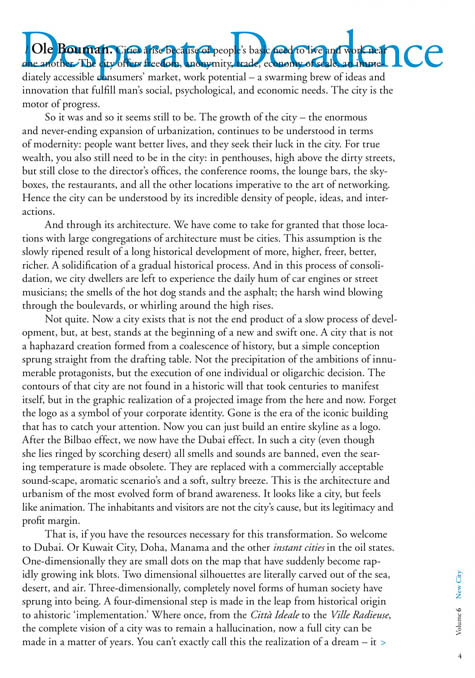 BLDGBLOG BLDGBLOG: Again in Volume #6, you differentiate between cities and what you call “large congregations of architecture.” I’m curious how this distinction plays out on the level of community, or local identity – what a region full of architecture might mean to its inhabitants.Bouman: If you don’t distinguish between those two – if you think that applying urban form is the same as building a city, or even creating urban culture – then you make a very big mistake. First of all, I think it’s necessary for architectural criticism, in that sense, to find the right words for these very complicated processes, to distinguish between two processes or forms that, at first sight, appear the same, but that are, in reality, very different. When Roemer van Toorn and I wrote the book The Invisible in Architecture in the early 1990s, we were directly reacting to an architecture culture which was taken hostage by the politics of the spectacular. It was an effort to figure out what was behind those fancy or glossy facades which were already highly present in the architectural press – and, in that sense, nothing has changed. There is still an incredible focus – not just among architects, but among clients – on an architecture that is strongest at first sight. The second sight or the third sight is not so important anymore. The invisible in architecture, in that sense, is still an interesting concept to explore: to figure out the intricacies of the architectural profession within a larger political context. Beyond that, distinguishing between a city and these “large congregations of architecture” may also help architects to clarify their own position, and to see how they might want to work – to help draft a new agenda for the discipline. This brings us back to that notion of agitation. So agitation can also mean: keep going, keep defining alternative agendas that are not well known – or well accepted, or that are just undiscovered – and keep opening windows for other kinds of practice. 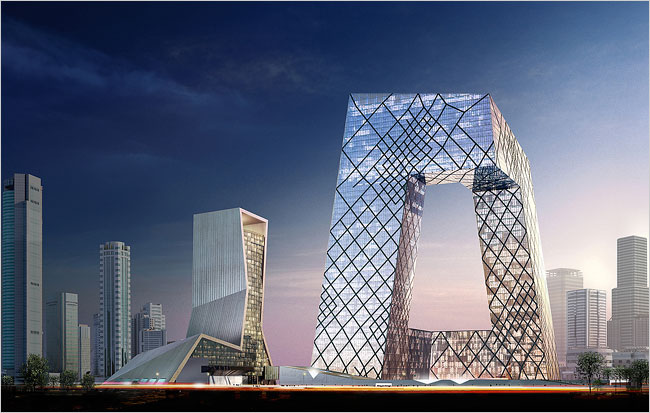 [Image: The CCTV building, Beijing, by Rem Koolhaas/OMA].BLDGBLOG [Image: The CCTV building, Beijing, by Rem Koolhaas/OMA].BLDGBLOG: In Volume #8, you write that China is “an emerging world for which we as yet have no concepts” – but perhaps we do have concepts for it, only we won’t find them in China: we’ll find them within the logic of Western globalization. Do you think, then, that the economic development of China is really just a mutant strain of something that has already happened in the West?Bouman: Well, there are many angles that could be taken, and I think that’s a good one. It’s strange that China is seen as a new world by many Westerners, a land of opportunity, a place they all want to go. Investors are also looking at China as where they would like to put their money. So, in a way, it’s very similar to concepts we already do have – the concepts of innovation, of career, of success. But also, the concept of a return on your investment, the concept of economic growth – all of those well-known elements of the Western worldview that we all share. On the other hand, China is still seen as another world. You have to go there. You have to get yourself a portfolio in China. Or you have to start your office, or open a new headquarters there – so there is always the concept of over there, of otherness. I talk to Chinese colleagues, and Chinese businesspeople, and they sometimes openly admit that this persistence of otherness, this persistence of the idea that this is a country that is different from the West, that you can go to, or send your money to, is helping China to take over. To put it dramatically. So, in terms of capital, for instance, if you just consider the fact that 15 years of boundless investment in China – hundreds of billions of dollars of investment in China, within a very Western paradigm of finding the best returns – is also, in the long-term, undermining the Western position. So, in a Western way of thinking, and from a capitalist point of view, investing in China may actually accomplish the opposite of what investors intended. These kind of paradoxes are hardly understood. If China is launching a new rocket, or a new satellite, or testing a new space weapon system, suddenly people wake up – but there is this strange anomaly between China as the promised land and China as the latent rival, the opponent, the growing danger. Either people accept that China is becoming part of a larger global system of capital, and so they aren’t afraid to give it its own momentum wherever it goes, or whatever it takes – that is just the price you pay for growth. Or you say: we can no longer accept this – and this might be a moment that is not so far away anymore, a moment of regression or conservatism. Some governments will say that we can no longer go there, maybe, because we would not like to add to the power and culture of China. It’s still very fashionable to host Chinese festivals and to invite Chinese artists and to buy Chinese art – but the moment might not be so far away when we ask: why would we pay for China? If it reinforces or strengthens their power? I feel sometimes that we are just a little bit away from the moment when this paradox, this anomaly, will erupt into a more existential question. What do we do? Do we keep adding to the strength of China? Or do we go back to this kind of Western chauvinism, or nationalism, and not allow architects, for instance, to work in China or to allow Western investors to invest in China? I think, in the work of Rem Koolhaas, for instance, this anomaly is almost already on the surface. On the one hand there’s this admiration of the great architect with an incredible track record who goes to build in China, who creates a new monument, a kind of signal of what architecture can do, an incredible achievement. On the other hand, there is this latent, almost open criticism: what does this do for China? Are we giving away our assets to the enemy? I think in the whole discussion around the CCTV Building you see this tension between chauvinism and internationalism, between western interests and the interests of globalization in general, and many other dialectics in the debate being played out through that specific building. That’s why the building is so interesting. As a metaphor, it represents much more than just the fact that it is built for an institution of Chinese power by a powerful western architect; it also reveals something that has to do with the dynamics of our culture – and where architecture can do that, then architecture is gaining in legitimacy. 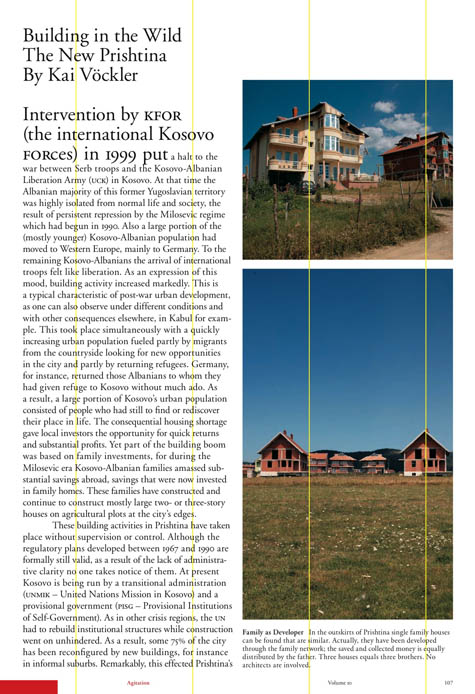 BLDGBLOG BLDGBLOG: I’m interested in your work – and Volume ’s work – with cities like Beirut, Ramallah, and Prishtina. Could you tell me a bit more about the role of architecture and urban design in so-called conflict zones ?Bouman: Well, first of all, there are many people there who need help – so it’s a very direct appeal to do something for people who may need you. I don’t have money, and I don’t have power, and I don’t have political influence – but what I can do, together with many other people, is, first, to acknowledge the need for cultural discourse. Very often all the discourse that is left to those people in post-conflict cities is about everyday needs, or maybe some rebuilding of political institutions; but culture is always at the end of the story, at the end of the line. What we can do is provide them with discourse, give them a certain vitality, as we did in Ramallah once, in Bosnia once, in Vilnius once – and even as we did at the feet of the Statue of Liberty once. If a city is in trouble, sometimes it’s good to organize dialogue, regardless of the subject matter – dialogue as a goal in itself. Of course, the second stage is the content – the subject matter of the dialogue. And for cities like Beirut or Prishtina, a very obvious subject matter is reclaiming the public domain. If there is a situation, as there is in many post-conflict cities, where political parties are extremely weak or even nonexistent, and where private citizens, sometimes criminals, have taken over the public domain because no one feels responsible – there are no owners, so to speak – then it is good to arrive quickly, and to figure out what the public domain can mean in that city. Beirut, especially now, seems to be a culture that is divided among factions. We’re trying to set up some projects in Beirut, and in the entirety of Lebanon, to specifically address the question of public domain. Or in Prishtina, for instance, there is an incredibly strong tendency to let the public domain be grasped not just by private interests, but by mafia, by criminals. So real estate is no longer an off-spin of the need to build; real estate becomes a modality of corruption, or an exemplification of corrupt wheelings and dealings. In that sense, it is important to be there, and to acknowledge the work of local architects, designers, civil servants: what they are doing is extremely important, and can be a model for a global discourse. It can be something that we learn from all over the world – because there are so many of those cities, and there is an increasing amount of those cities, that need to learn these lessons. So we try to go there, to acknowledge the problems, sometimes to help – with just ideas – and to give it exposure; but also to give the local protagonists a certain momentum by connecting them to the international discourse. And if you live in Beirut, or Prishtina, or Ramallah, it might be an incredible thing to feel connected to a more general international discourse. 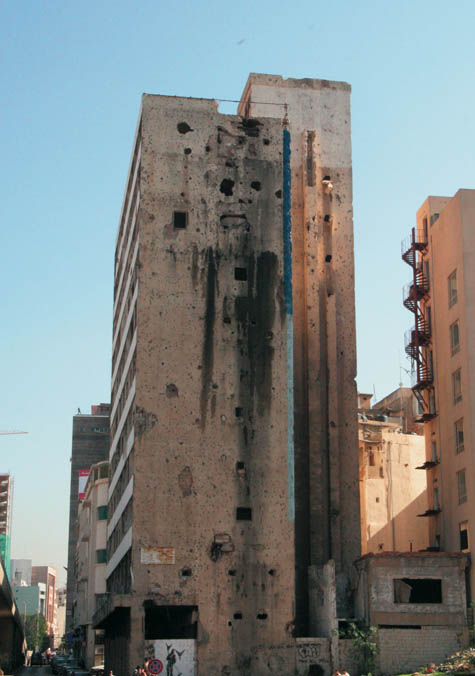 BLDGBLOG BLDGBLOG: When you go there, who exactly are you networking with? Architects? Civil servants?Bouman: When we decided to go to these places and to organize a dialogue there, we started a practice called RSVP Events. We published an invitation to participate, and we just mentioned the place and the date and the subject matter. People who felt responsible, or who were interested, and who might show up on that date, could react by way of email. After collecting the people who might be interested, we started an email dialogue with this group. And the background of those people was always different – you might find an activist group, or a cultural institution, or a student association, or a school, and they would turn out to be the main provider of content, or the main provider of people, to help. So it’s always different. In Ramallah, we did a conversation with an organization specifically responsible for heritage in Palestine – in the West Bank – which was a very unexpected turn of events. In Zagreb we worked with a group of students. In Vilnius we were at an art museum. It’s really not fixed – it’s an open system – and it should be that way. We are trying to set up a new series this year, and, like Beirut and Kosovo, we are planning on going to Ulaanbaator, to Chennai, to Taichung, to Tijuana – different places in borderline situations – and I’m very curious who will eventually help us. We have no institutional connections yet, but we need some; that will help us find a larger audience. We urgently need, always, the email lists, and the local groups that may sustain an event like that.
 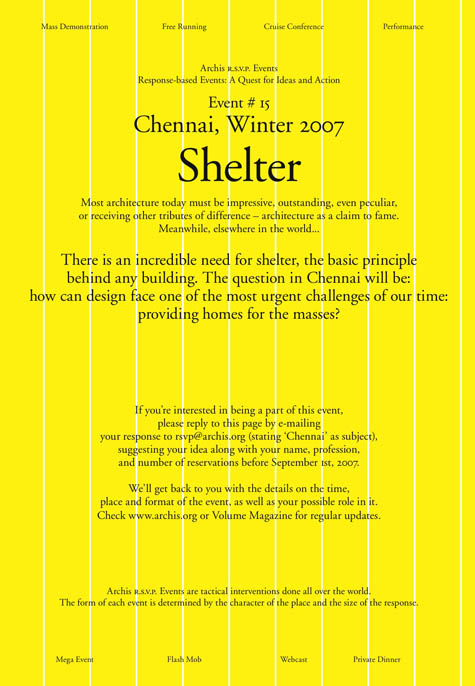 BLDGBLOG BLDGBLOG: Finally, as far as your new job goes – becoming Director of the Netherlands Architecture Institute on April 1, 2007 – what are your specific plans? Bouman: [ laughs] That’s a huge question – and it’s a question I’m still in the middle of answering. I haven’t found the words for it yet. Mainly, my role there will be in the spirit of taking architecture as a cultural medium, not just as a profession – taking architecture as a way of thinking, as a metaphor for society, as a medium for culture, and as a very rich historical discipline that can address larger issues. Architecture is more than just serving the spatial needs of society, or providing technical solutions by professionals. Architecture is done by professionals, but that shouldn’t inhibit it to ask the questions of an amateur – very open, curious questions that are larger than just the service, or the facilities, the professional interests of that discipline. Most of the time, when you find a podium, it is outside the discipline – and, as I said, that’s still successful – but I often wonder why architecture doesn’t seize the opportunity to make itself much more legitimate – more useful, in a way. I think presenting architecture as a potential, a capacity, to pose big questions and to draft agendas that are larger than architecture itself might be a good characterization of things I have in mind. • • •With special thanks to Benedict Clouette, of Columbia University's C-LAB, for setting this interview up and assisting me with images (all unlabeled images come from Volume); and to Ole Bouman for taking the time to talk.
There are at least two events in New York City this week worth checking out, both sponsored by the Forum for Urban Design (who also publish the Urban Design Review). 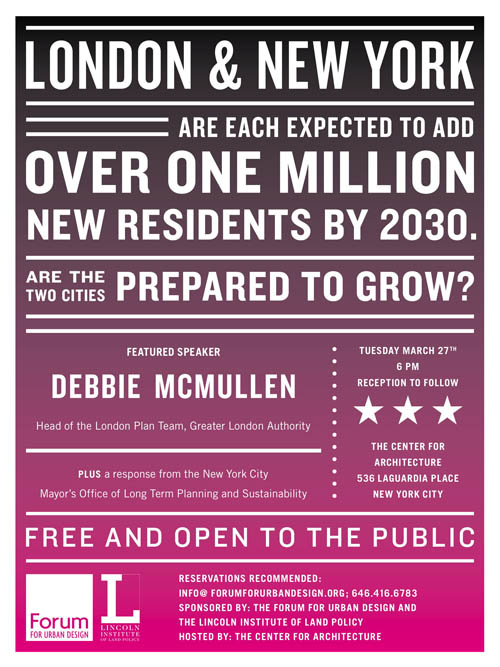 Tomorrow night, for instance, Debbie McMullen, Head of the London Plan Team for the Greater London Authority, will be speaking about sustainable urban development in an era of rapidly growing populations. "London and New York are each expected to add over one million new residents by 2030," the Forum tells us. "Are the two cities prepared to grow?" There will then be a response from the New York mayor's own Office of Long Term Planning and Sustainability. Since I won't be able to attend, however, let me know if someone asks her about London's congestion charge, public transportation, and the prospect of a car-free Manhattan... Three things I'm a big fan of. 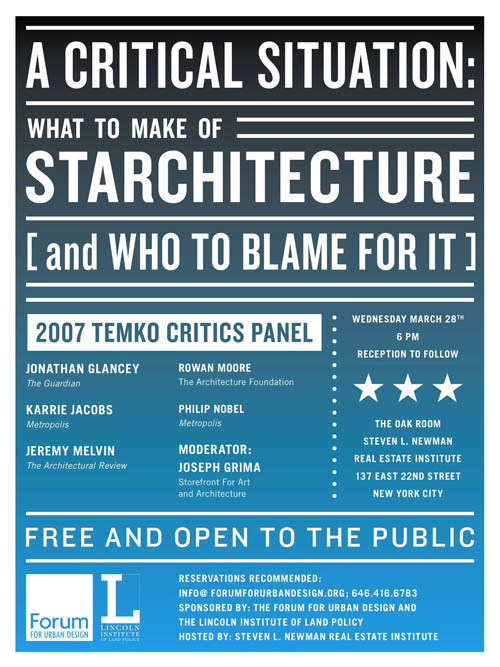 Then there's a panel discussion on Wednesday night about starchitecture – what to do about it and who's to blame. Panelists include Karrie Jacobs and Jonathan Glancey, and the whole thing will be moderated by Joseph Grima, the new head of the Storefront for Art and Architecture. Both events are free and open to the public – and location, time, etc., appears on the flyers, featured here. If you want truly gigantic versions of both images, however, click here and here. Have fun!
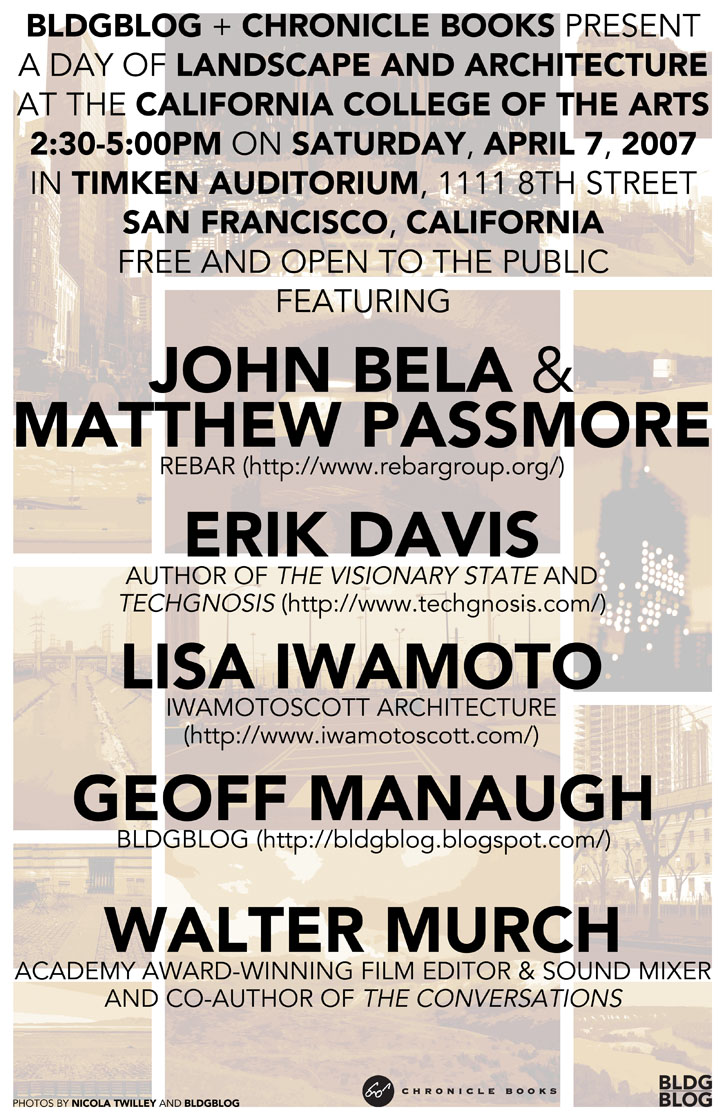 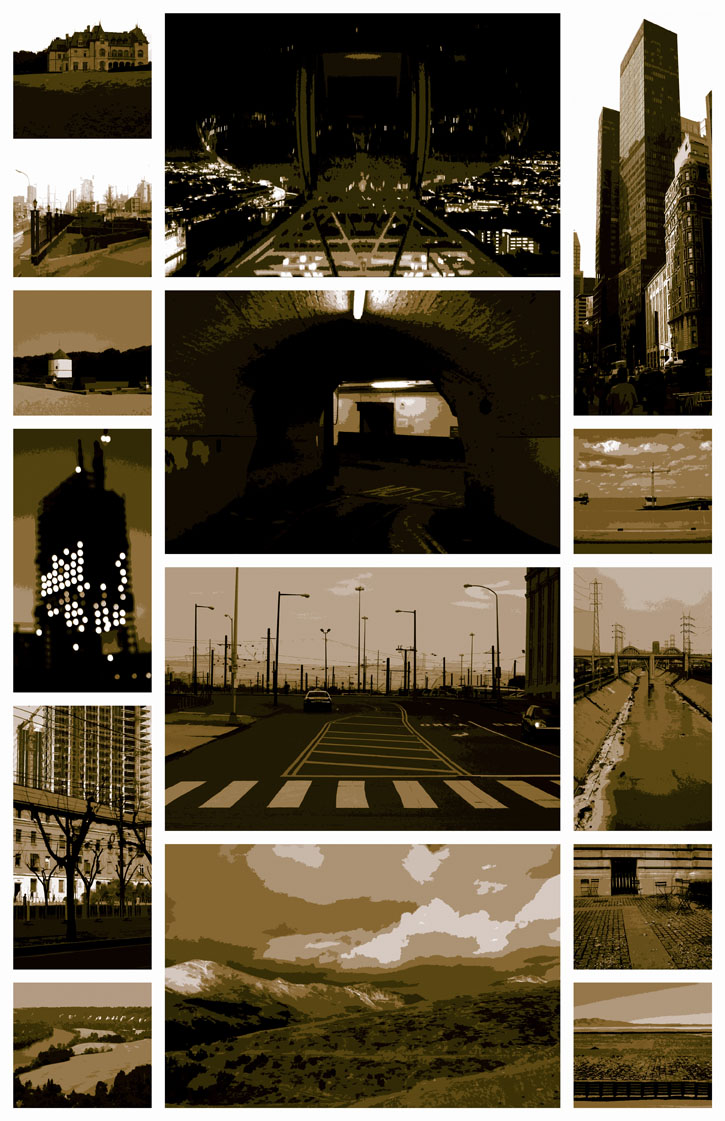 [Image: Larger versions available here and here]. [Image: Larger versions available here and here].
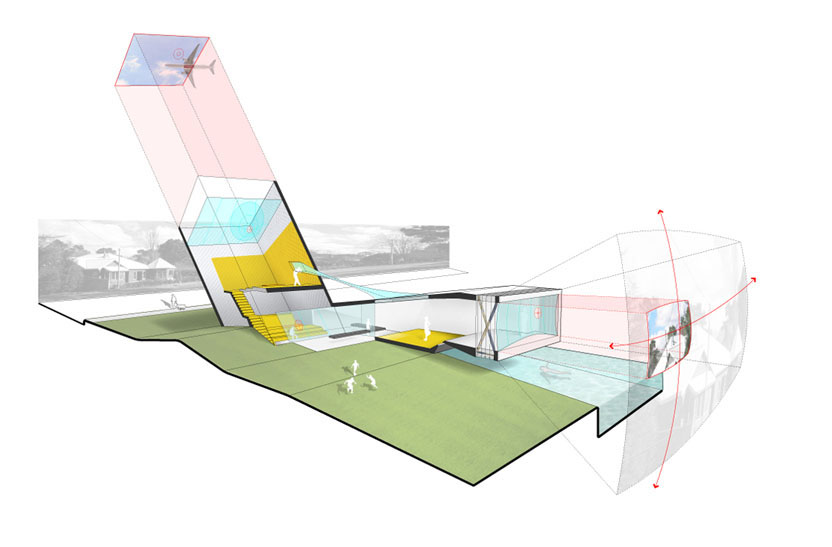 [Image: The Mix House, exterior view]. [Image: The Mix House, exterior view].This awesome new project by Joel Sanders Architect, Karen Van Lengen/KVL, and Ben Rubin/ Ear Studio takes a step beyond "the modernist notion of visual transparency" (i.e. large windows and glass houses) by adding "aural transparency" – acoustic openness. 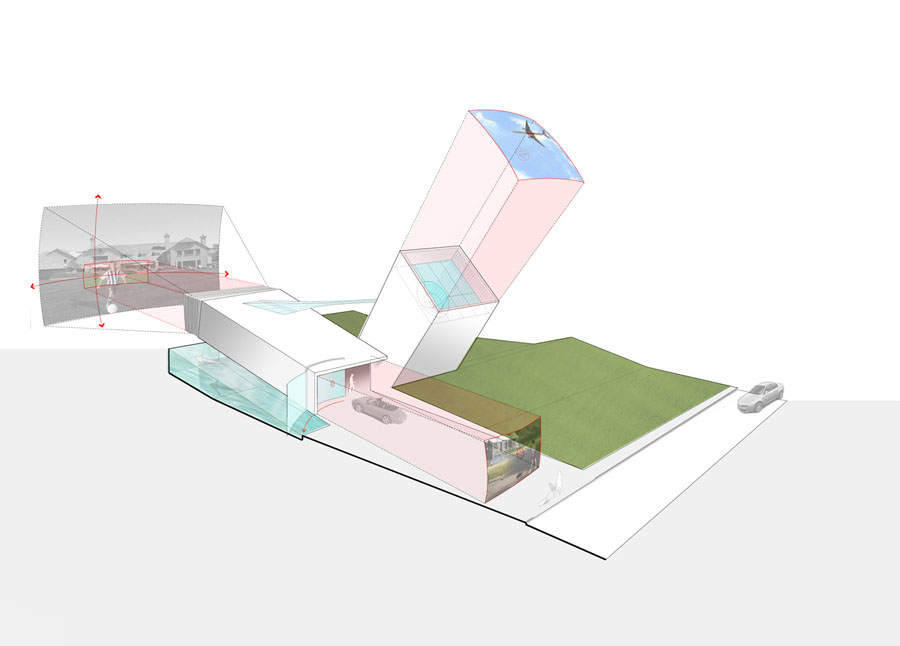 [Image: Mix House, exterior]. [Image: Mix House, exterior].It's called the Mix House: Situated on a generic suburban plot, the dwelling is composed of two sound-gathering volumes outfitted with three audiovisual windows. The curved profile of each of these sonic windows is composed of two elements: a louvered glass window wall that regulates the sound of the air-borne ambient environment, and a parabolic dish that electronically targets domestic sounds and transmits them to an interior audio system controlled from the kitchen island. From this sound command center of the house, occupants are free to design original domestic soundscapes by mixing media sponsored sounds with the ambient noises of the neighborhood. These "sonic windows" – or parabolic ornaments – amplify the audio setting of the house, thus making location, I'd think, several orders of magnitude more important than with many others works of architecture. In fact, should a house like this really be constructed in the suburbs? Instead of deep in the woods somewhere, or even on top of a glacier...? Crystalline pressures of melting ice three thousand feet below you suddenly break, sending cascades of sound shivering upward through the home's foundations. Some days it's impossible to get out of bed, hypnotized by unearthly noises... 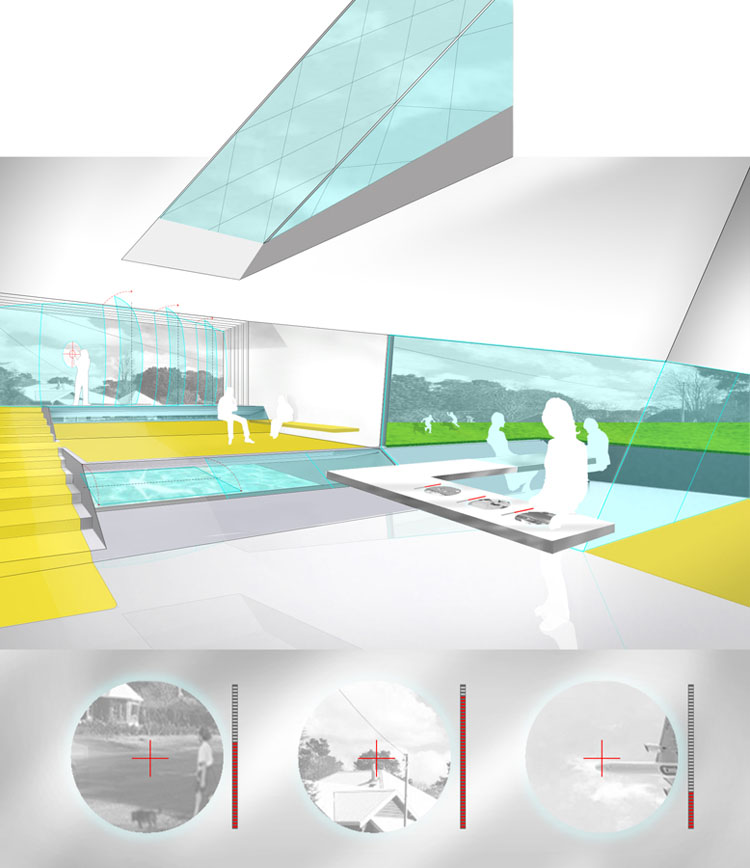 [Image: Mix House, interior]. [Image: Mix House, interior].In any case, the "den/bedroom wing is oriented vertically to capture audio-visual views of the sky," we read, and "the front window wall doubles as a sliding glass door that allows the occupant to hear the sounds of the streetscape." Further: "Located above the bed, the skylight captures sky-borne sounds, as well as signals transmitted through TV and Internet connections." It's architecture as the cure for – or cause of? – schizophrenia. 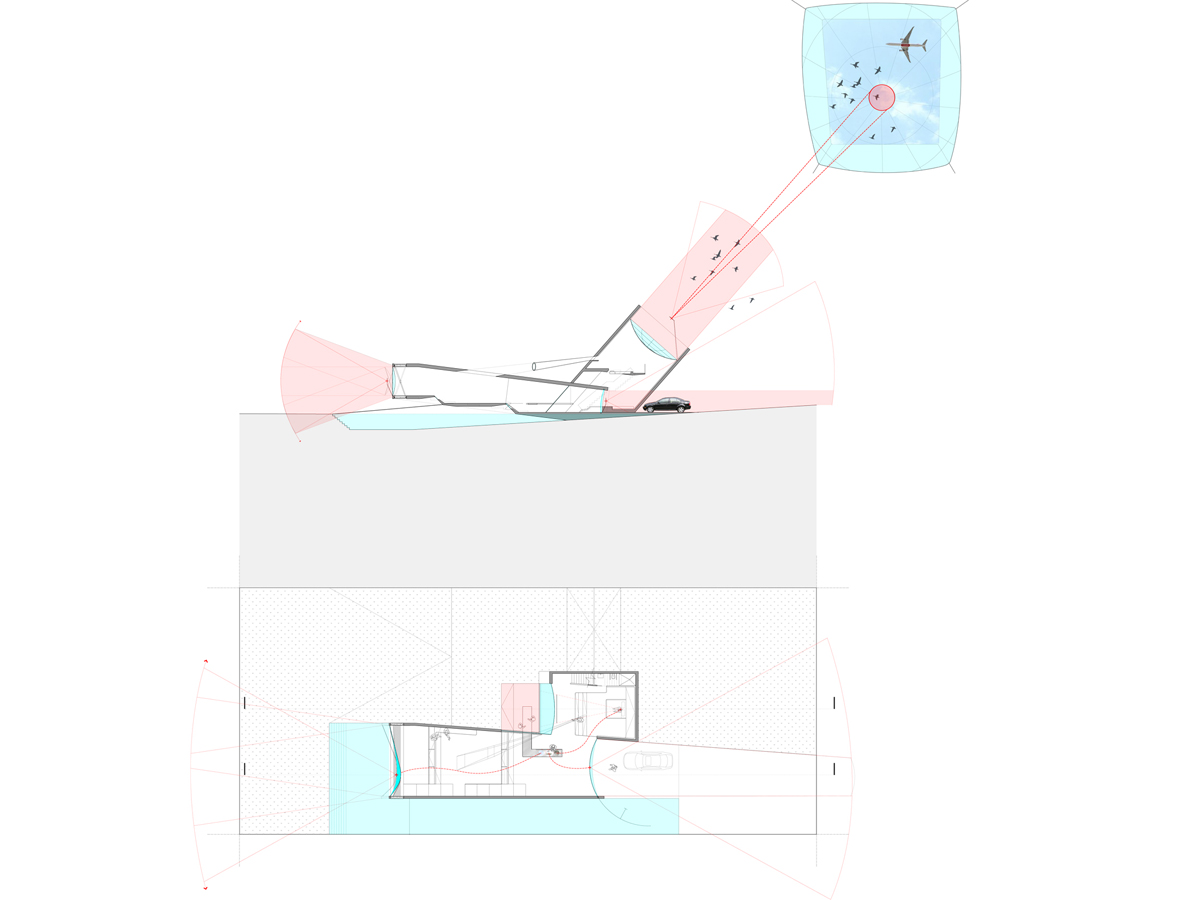 [Image: Mix House, exterior section and plan]. [Image: Mix House, exterior section and plan].The artistic possibilities here are extraordinary. One wonders, for instance, if several of these houses could be constructed in the same neighborhood, on the same street – with each one then hooked up to public broadcasting equipment and loudspeakers. Pirate radio. Cul-de-sac FM. The houses thus play sounds for each other, like instruments, orchestrally contributing to the neighborhood's sonic environment – becoming part of one another's "audio-visual views." Each house – already an outside-in acoustic snapshot of the environment in real-time – turns sound around to offer a corresponding inside-out anthem for the streets and passers by: the clinking forks and knives of a private dining room get broadcast onto the street. A kind of architecturally outside-inside-out soundtrack for the local world.  [Image: Mix House, amplifying window technical detail]. [Image: Mix House, amplifying window technical detail].Drunk homeowners mix burps with airplane roars, standing at an audio booth in the kitchen. Someone plays layered tape-loops of the sounds of their house from yesterday – which gets picked up by the neighbor and rebroadcast, with reverb, over the noise of a distant lawnmower. Enemy teenagers declare audio warfare, their microphones left open all night long. Paranoid husbands spy on all possible rivals. Then, in 2017, a particularly well-constructed house, full of weird audio equipment, becomes the only instrument used to soundtrack Steven Spielberg's final film... (Thanks to Rob Kerchner and Joel Sanders for sending me the images! Meanwhile, the Mix House will be on display as part of Open House: Architecture and Technology for Intelligent Living at the Art Center College of Design in Pasadena, from April 14-July 1, 2007).
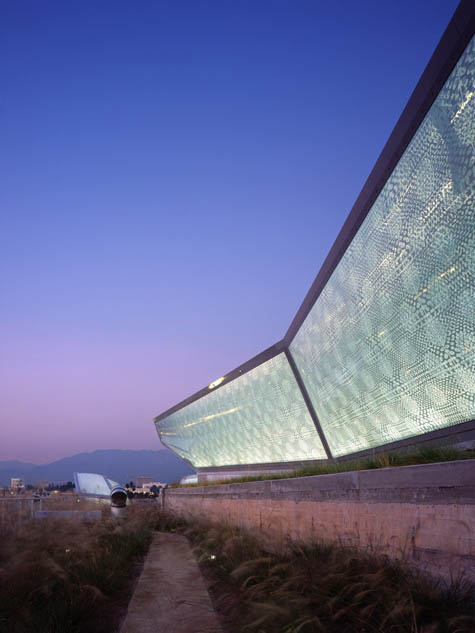 [Image: On the roof of the wind tunnel, lit from below... Photograph courtesy of Benny Chan/Fotoworks]. [Image: On the roof of the wind tunnel, lit from below... Photograph courtesy of Benny Chan/Fotoworks].As some of you will no doubt know, BLDGBLOG and Materials & Applications have co-organized an awesome event coming up on Tuesday, May 8, from 8-10pm, at the Art Center College of Design in Pasadena. It will be part of this year's Silver Lake Film Festival. The speakers? Ryan Church, James Clyne, Mark Goerner, and Ben Procter, discussing artistic connections between film, architecture, science fiction, and the city. The venue? A converted wind tunnel, formerly owned and operated by Douglas Aircraft, recently rehabbed by Daly Genik Architects. 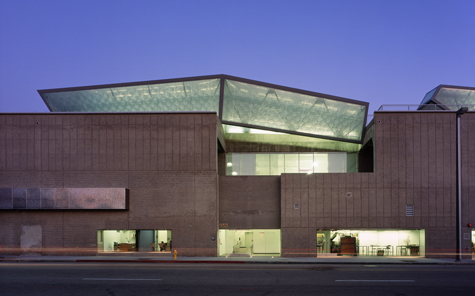 [Image: Courtesy of Benny Chan/Fotoworks]. [Image: Courtesy of Benny Chan/Fotoworks].For the project, Daly Genik led the "transformation of an industrial wind tunnel and support buildings" into a 24-hour arts education facility, complete with studios, classrooms, galleries, and offices – yet it's the outside of the building that I find the most interesting (the wind tunnel itself, sadly, is just sort of a gigantic room with a huge ceiling). "The wind tunnel’s complex of concrete buildings had few windows," the architects explain. This meant there were a bunch of "large, uneven, dark spaces" inside that needed brightening: To open up the building, we cut windows and skylights in the thick street-front concrete walls and the roof, bringing light into classrooms and studios while making the program visible to the street. A certain amount of light escapes as a beacon allowing the skylights and signage to make the building glow. These "strategic cuts," in other words, now function both as light wells – or "sculptural skylights" – bringing sunlight in, and as lanterns, illuminated from below. 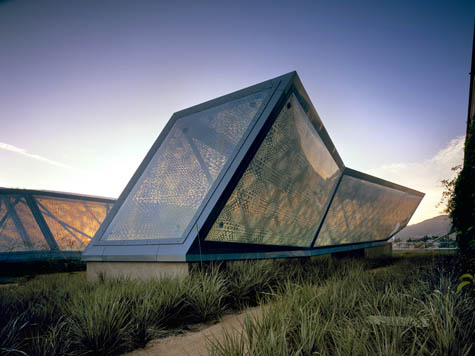 [Image: Courtesy of Nic Lehoux]. [Image: Courtesy of Nic Lehoux].Further, because the architects "wanted the skylight installation to demonstrate an integration of design disciplines: structure, architectural form, and graphic design," they worked "in collaboration with graphic designer Bruce Mau, ARUP structural engineers and Foiltec technicians." More technically, the skylights are "an assembly of translucent ETFE films stretched on a structural frame." These "films," however, are information-bearing; that is, the "surface can be printed with a pattern." However, this "printing" process is rather complex. 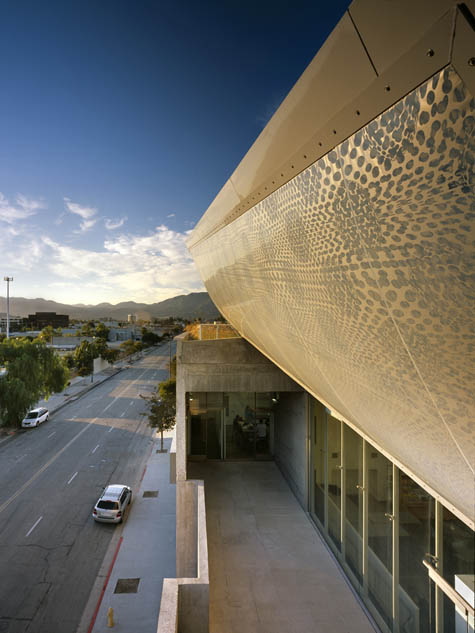 [Image: Courtesy of Nic Lehoux]. [Image: Courtesy of Nic Lehoux]."In order to print the foil," for instance, that foil must first be "irradiated with a high frequency energy source, then printed with cut rubber rollers." Beyond even that, then, Bruce Mau – hired to design the print – was specifically asked to optimize the pattern "so that correct amounts of light would be transmitted" down to the classrooms below. The interior space of the building thus appears to be stippled with indirect sunlight. 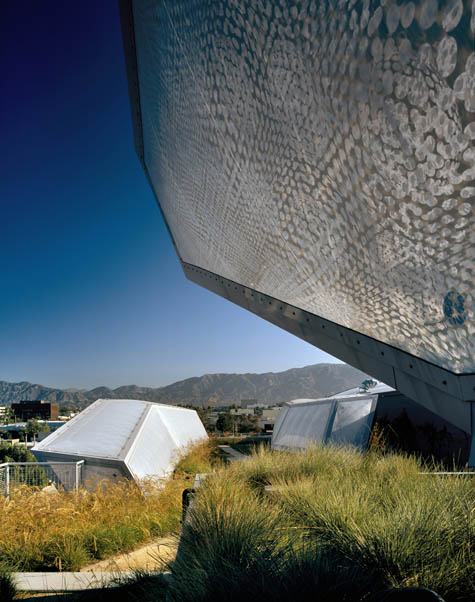 [Image: Courtesy of Nic Lehoux]. [Image: Courtesy of Nic Lehoux].Finally, what appear to be solid light-boxes on the roof of the building are actually "huge pillows." A "compressor is needed to keep the pillows inflated... [and] to adjust the amount of natural light and heat entering the building... A timer, a seasonal clock, or light and thermal sensors can control the reinflation process." This system is part of the reason why the building was granted LEED certification by the U.S. Green Building Council. In any case, come out on May 8 to step inside the building and see the wind tunnel itself – and to hear about science fiction, film, urban space, and architecture. More information on that event appears here. (Thanks to Meara Daly for sending me the images! The Wind Tunnel was also covered, nearly three years ago, on Land+Living – who point us onward to this article in Metropolis).
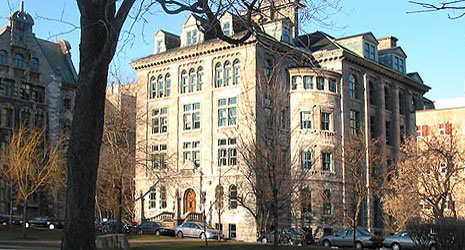 [Image: The Macdonald-Harrington Building at McGill, home of both the Urban Planning and Urban Design programs]. [Image: The Macdonald-Harrington Building at McGill, home of both the Urban Planning and Urban Design programs].Just a quick congratulations to my brother, Kevin, who's been accepted into the McGill School of Urban Planning. Congrats, Kevin! Be nice to him.
 [Image: Ben Procter]. [Image: Ben Procter].A few weeks ago I announced that BLDGBLOG and Materials & Applications had teamed up to curate an architectural film fest as part of this year's Silver Lake Film Festival here in LA. Well, I have some exciting news to announce: on Tuesday, May 8th, from 8-10pm, inside a converted wind tunnel in Pasadena, we'll be hosting an evening full of talks and presentations about film, science fiction, space, landscape, and architecture.  [Image: James Clyne]. [Image: James Clyne].I have said many times before on this blog that contemporary architecture could learn quite a lot from the spatial and material imaginations on display in both film and science fiction – so perhaps this event will be a good opportunity to explore what that really means. 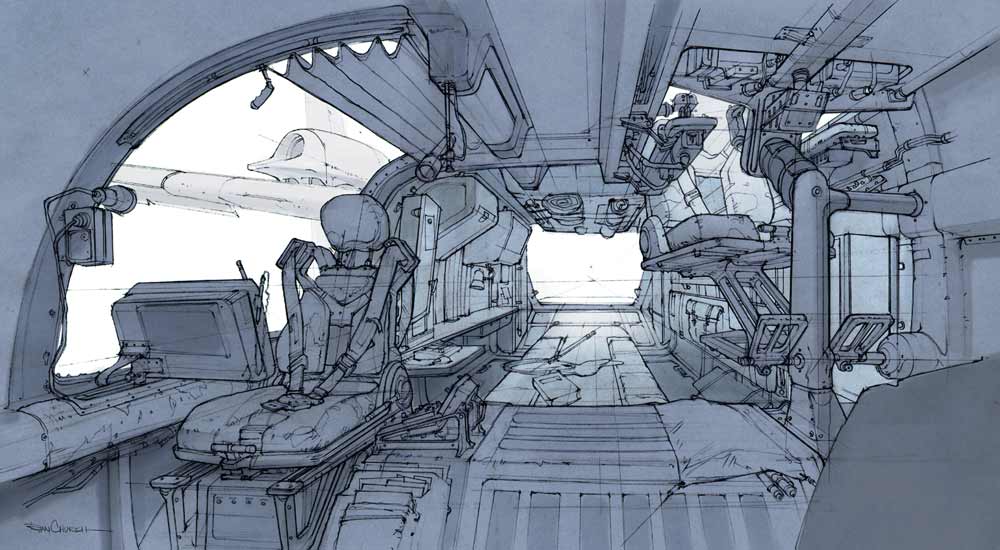 [Image: Ryan Church]. [Image: Ryan Church].Though the connections between film and architecture run too deep – and are either too widely known or too conceptually entangled – to discuss in full here, I still think it's worth pointing out, briefly, a few examples of cinematic thinking in architecture. Or architectural thinking in cinema, as it were. One of the greatest essays on Piranesi ever written, for instance, was produced by Russian film director Sergei Eisenstein – whose father, interestingly, was an architect. While studying Piranesi's notoriously vertiginous etchings of imaginary prisons, Eisenstein felt moved to write an essay about the basic cinematic acts of montage and cutting. If Piranesi's prisons are anything, Eisenstein suggests, they are spaces edited together from unrelated episodes; they are cinematic. He calls them "architectural frenzies." Inspired by this realization, Eisenstein goes on to say that even film should be reconsidered, on a structural level, as "a sequence of collisions," a "succession of broken links," thousands and thousands of different frames and spaces that then unite into a coherent whole. The individual stills of a film sequence – like the individual rooms of a building – thus fuse into an "ecstatic construction." 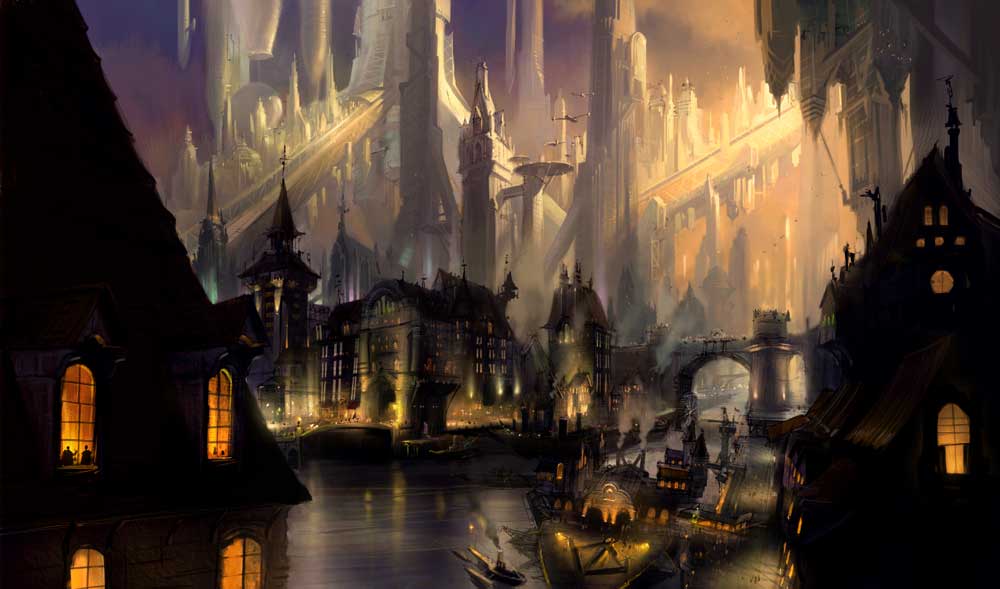 [Image: Ryan Church]. [Image: Ryan Church].Less abstractly, Jonathan Glancey claims, in an old article for The Guardian, that "cinema remains the best place to experience the architectural imagination at full flight." Through film, Glancey writes, an audience can get "highly wrought glimpses into future cities; for popular audiences, such films offer thrilling guides as to how our world might look." He continues: What is fascinating, and very much an area for further research, is the close relationship between radical architectural design and the cinema. Much of the best of modern architecture, combining digital and three-dimensional design processes, is cinematic in scope and feeling. He then concludes, and I strongly echo this sentiment: If only the members of Archigram or Superstudio had been able to buy, in the 1960s, the kind of cheap digital technology available on high streets today. They may not have been able to get their dream cities constructed, but they could have visualised them in mini-movies – much more enticing than so many drawings, lectures and models. After reading something like this, though, I find it very hard not to get excited by things like Unit 15 at the Bartlett School of Architecture, a design studio that "uses film, video, animation and motion graphics to generate, develop, refine and represent architectural proposals." It's also interesting, though, in this context, to point out the work of M. Christine Boyer, and her excellent book The City of Collective Memory. There, Boyer writes about Edward Gordon Craig, an early 20th-century stage set designer (and son of an architect), whose "architectonic scenery" foregrounded architectural backdrops, turning them into the only action an audience was meant to watch. For instance, Craig "proposed that a stage in which walls and shapes rose up and opened out, unfolded or retreated in endless motion could become a performance without any actors," Boyer writes. "The stage thus became a device to receive the play of light rhythmically, creating an endless variety of mobile cubic shapes and varying spaces. Deep wells, stairs, open spaces, platforms, or partitions created a stage of complete mobility, which Craig believed appealed to the imagination." The architecture does all the acting for you; the architecture is the film – or the play, as the case may be. The architecture is the storyline. The space itself is the plot.  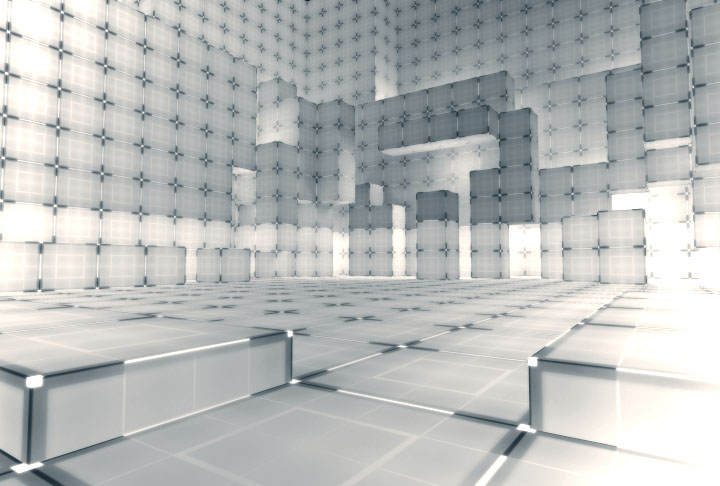 [Image: Ben Procter]. [Image: Ben Procter].So what does all this have to do with cinema and architecture – or even with science fiction and the city? Well, by talking not to architects but instead to the people who actually design the sets, backdrops, cityscapes, environments, buildings, rooms, etc., in which cinematic action takes place – from X-Men 3 to Charlie and the Chocolate Factory – you should be able to get at least some sense for what architecture can mean, on a narrative level, to those outside the architectural field. In other words, what do those people who tell stories through and with space actually want from architecture? How do they use space? Rather than set out to discover, yet again, what architects think about cinema – or about science fiction, or about stage set design – why not turn the question around? Why not see what architects can learn from spaces, buildings, and cities produced by other fields?  [Image: A sketch by Mark Goerner; here's a larger version]. [Image: A sketch by Mark Goerner; here's a larger version].Or, to ask another question that won't necessarily be answered by this event: if Architectural Record bills itself as a magazine about architecture, then why doesn't it ever cover, say, the apartment complex from Minority Report, or the office lobbies featured in The Matrix? That's architecture, too. In any case, Materials & Applications and BLDGBLOG have therefore gathered together four of the most exciting concept artists working in film today to discuss some of these questions, and to talk about their own artistic backgrounds – how they got into film, what they studied to get there, and what imaginative role architecture plays in their creations. They will each give a short, 15-20 minute talk, with images, and the whole thing will be followed by a Q&A. And, just to mention this again, because I love saying it, this will take place in a converted wind tunnel, formerly used for testing the aerodynamism of experimental vehicles. But I'll be posting about the wind tunnel in a few days (complete with some really cool pictures). 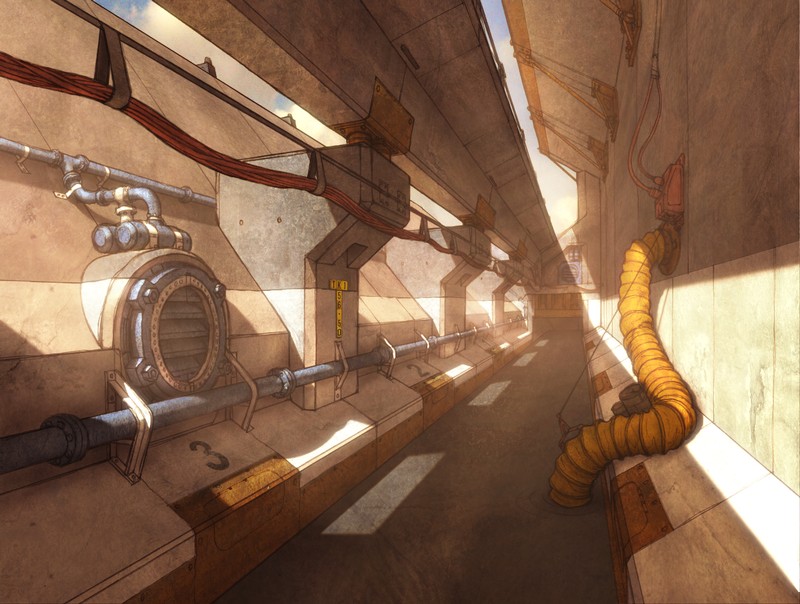 [Image: Ben Procter]. [Image: Ben Procter].The resumes of these four guys, then, put together, cover so much cinematic ground that it's almost easier to name what they haven't worked on; nonetheless, here are the speakers – with an abbreviated list of their film production credits. In alphabetical order, you'll see Ryan Church, James Clyne, Mark Goerner, and Ben Procter. 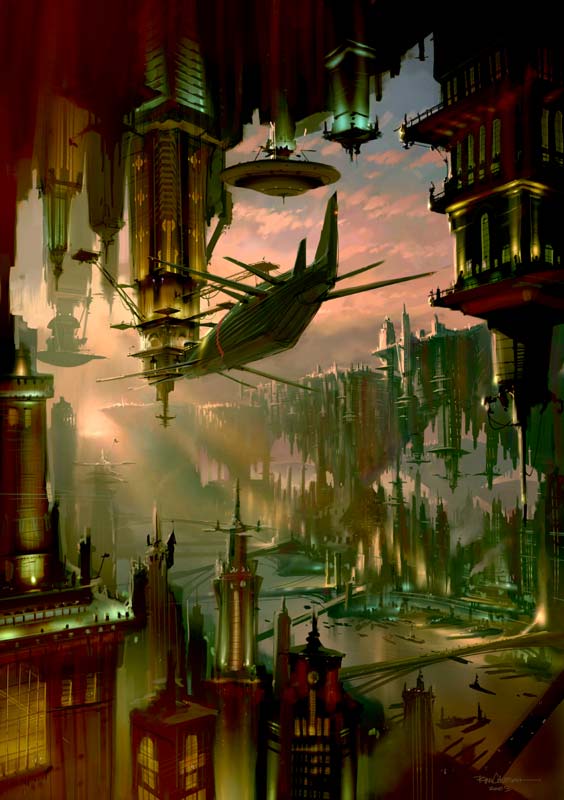 [Images: Ryan Church]. [Images: Ryan Church].Ryan Church has worked on The War of the Worlds, Star Wars II: Attack of the Clones, and Star Wars III: Revenge of the Sith – with stills from each film available on his site. Some of the landscapes and structures that Ryan has produced are just extraordinary; there's this titan arch vs. these linked arches; there's this weird interior full of glowing discs; there's this thing; there's the Death Star under construction – etc. etc. etc. Awesome work can be found all over this page, in fact, including some truly amazing sketches.  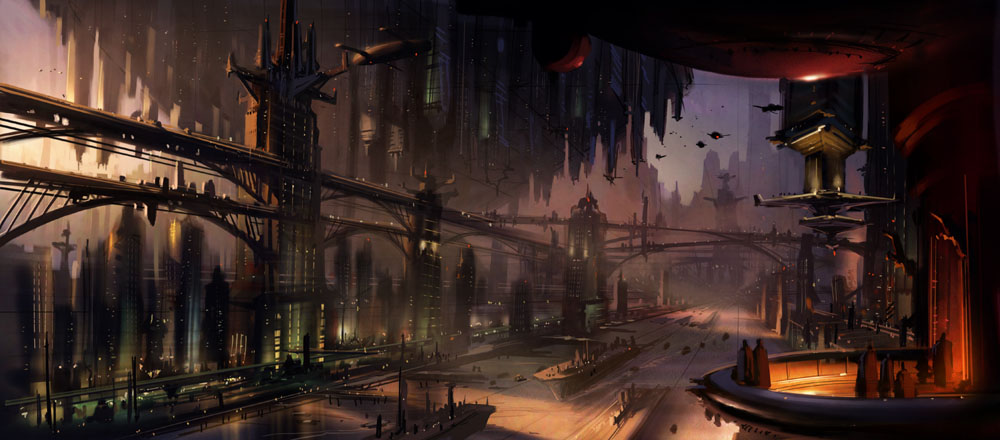 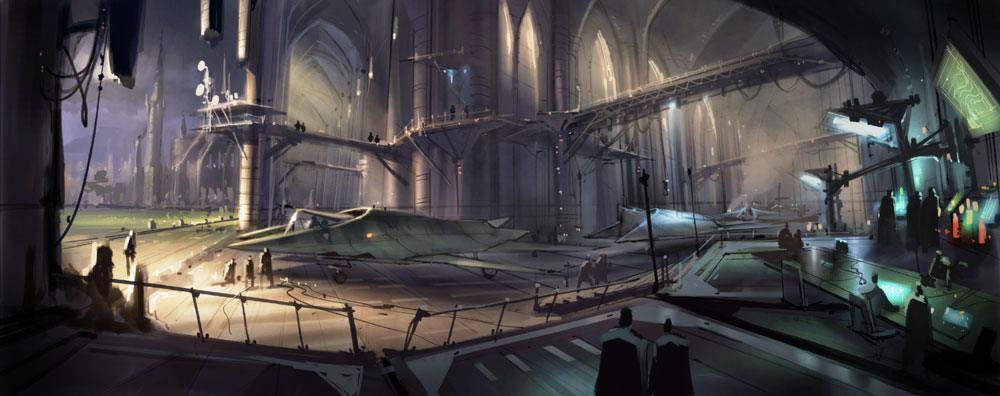 [Images: Three environments by Ryan Church; larger versions available here, here, and here]. [Images: Three environments by Ryan Church; larger versions available here, here, and here].Check out Ryan's bio for more. Moving onward, alphabetically, we find James Clyne, who has worked on A.I. (check out this Caspar David Friedrich-esque landscape, in particular), Charlie and the Chocolate Factory ( !), Fear and Loathing in Las Vegas, Minority Report (including this cityscape and these freeways), Mission to Mars, The War of the Worlds, and X-Men 3, among others.  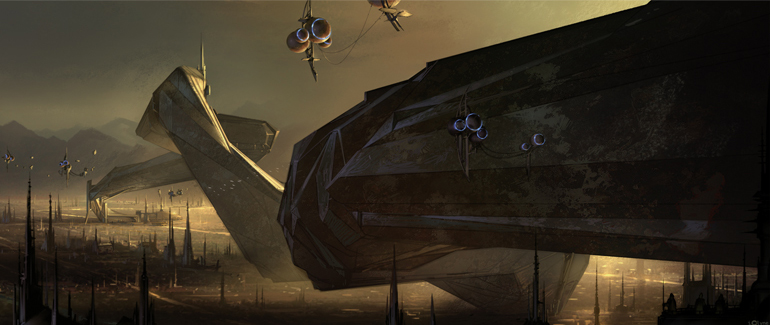 [Images: James Clyne]. [Images: James Clyne].There's then Mark Goerner, who's worked on Constantine, Minority Report, The Terminal, and X-Men 2 (including Magneto's plastic prison), among others. Check out this crashed ship-city, piercing the lunar surface, in both sketch and final versions. 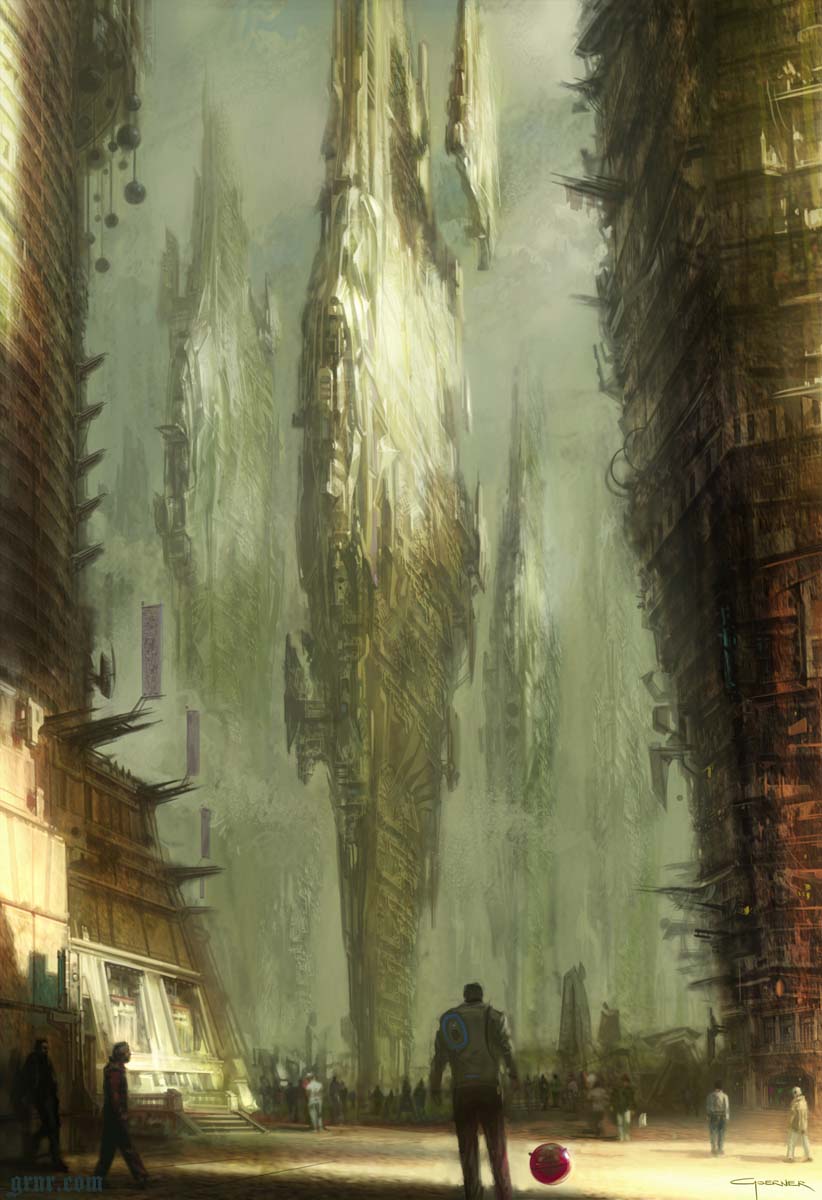 [Image: Reef City by Mark Goerner]. [Image: Reef City by Mark Goerner].Of course, Mark has also designed a space station. Ben Procter, finally, has worked on a bewildering number of films, including the forthcoming, feature-length version of The Transformers. His work also appears in Blade 2, Charlie and the Chocolate Factory, The Matrix: Reloaded and The Matrix: Revolutions, Pirates of the Caribbean, The Ring, Sky Captain and the World of Tomorrow, Superman Returns, and The Terminal, among others.  [Image: Ben Procter]. [Image: Ben Procter].Ben has produced environments for games such as Need for Speed: Underground, and he's even helped spatially conceptualize a few music videos for Mariah Carey, Ginuwine, and Busta Rhymes. 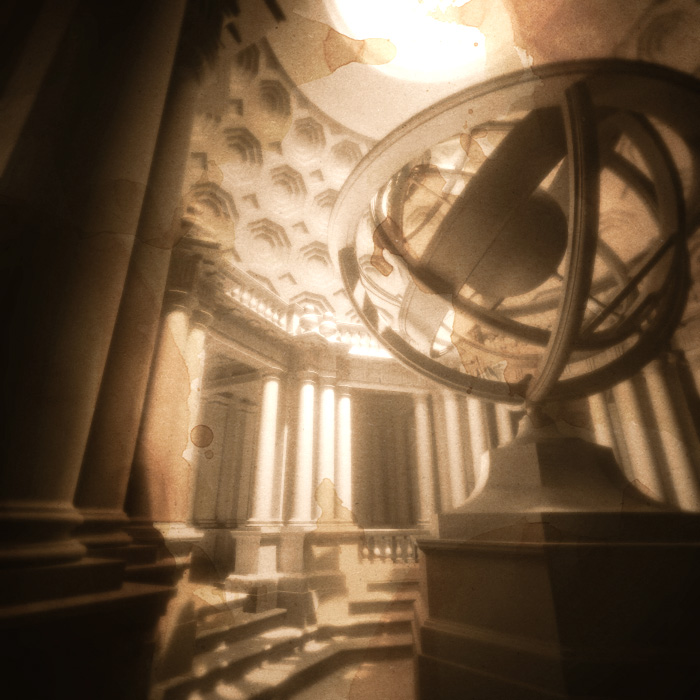 [Image: Ben Procter]. [Image: Ben Procter].His resume has more information (available as a PDF). So come out if you can on May 8, 2007, from 8-10pm, at the Art Center College of Design in Pasadena. Hear about film, architecture, and science fiction; learn how these artists were educated and how they found the careers that they did; ask questions about artistic influences, strategies, and intentions; find out what it's like to work on a Steven Spielberg film; and see some more of their work, from film stills to sketchbooks to video clips. The former wind tunnel, meanwhile, is absolutely enormous, so there's no need to worry about reservations or whether you'll be able to get in. And bring some extra cash, in case you want to purchase one of their instructional books or DVDs; they're cool guys and deserve the support. And I'll repost about all this once the event draws closer, complete with address, etc. etc., so don't worry if you read this post and don't know how to get there. The event is nearly two months away. Don't panic.  [Image: A sketch by Mark Goerner; here's a much larger version]. [Image: A sketch by Mark Goerner; here's a much larger version].Expect more soon...
|
|
 [Image: Photo by Kim Johnson Flodin/Associated Press, via the New York Times].
[Image: Photo by Kim Johnson Flodin/Associated Press, via the New York Times]. [Images: Via the BBC].
[Images: Via the BBC].
 [Image: A page-spread from
[Image: A page-spread from  Or: as a child you went on holidays with your auntie to a small village in southern France, but now you're 63 years old and you haven't been there in half a century. So you hire a car and you drive down, alone, crossing the
Or: as a child you went on holidays with your auntie to a small village in southern France, but now you're 63 years old and you haven't been there in half a century. So you hire a car and you drive down, alone, crossing the  To bide the time before driving back north, you do some casual gardening out back, screwing around with a shovel and wondering why, as you tried to go back to find the past, everything fell out from beneath you – when you discover something: foundation stones. You clear away more dirt and stare.
To bide the time before driving back north, you do some casual gardening out back, screwing around with a shovel and wondering why, as you tried to go back to find the past, everything fell out from beneath you – when you discover something: foundation stones. You clear away more dirt and stare.  [Image: The new Burmese capital of Naypyidaw, photographed by the Associated Press; via the
[Image: The new Burmese capital of Naypyidaw, photographed by the Associated Press; via the  [Image: Courtesy of the Associated Press, via the
[Image: Courtesy of the Associated Press, via the  [Image: Courtesy of the Associated Press, via the
[Image: Courtesy of the Associated Press, via the  [Image: A sketch by
[Image: A sketch by  [Image: A sketch by
[Image: A sketch by  For instance, Bouman says: "if you think that applying urban form is the same as building a city, or even creating urban culture, then you make a very big mistake." He goes on to describe how "architecture culture" in the mid-1990s "was taken hostage by the politics of the spectacular."
For instance, Bouman says: "if you think that applying urban form is the same as building a city, or even creating urban culture, then you make a very big mistake." He goes on to describe how "architecture culture" in the mid-1990s "was taken hostage by the politics of the spectacular." [Image: Ole Bouman, photographed by Cassander Eeftinck Schattenkerk].
[Image: Ole Bouman, photographed by Cassander Eeftinck Schattenkerk]. [Image: Bullish on Wall Street; image
[Image: Bullish on Wall Street; image  BLDGBLOG: In
BLDGBLOG: In  BLDGBLOG: Again in
BLDGBLOG: Again in  [Image: The CCTV building, Beijing, by Rem Koolhaas/
[Image: The CCTV building, Beijing, by Rem Koolhaas/ BLDGBLOG: I’m interested in your work – and
BLDGBLOG: I’m interested in your work – and  BLDGBLOG: When you go there, who exactly are you networking with? Architects? Civil servants?
BLDGBLOG: When you go there, who exactly are you networking with? Architects? Civil servants? BLDGBLOG: Finally, as far as your new job goes – becoming
BLDGBLOG: Finally, as far as your new job goes – becoming  Tomorrow night, for instance, Debbie McMullen, Head of the London Plan Team for the
Tomorrow night, for instance, Debbie McMullen, Head of the London Plan Team for the  Then there's a panel discussion on Wednesday night about
Then there's a panel discussion on Wednesday night about 
 [Image: Larger versions available
[Image: Larger versions available  [Image: The Mix House, exterior view].
[Image: The Mix House, exterior view]. [Image: Mix House, exterior].
[Image: Mix House, exterior]. [Image: Mix House, interior].
[Image: Mix House, interior]. [Image: Mix House, exterior section and plan].
[Image: Mix House, exterior section and plan]. [Image: Mix House, amplifying window technical detail].
[Image: Mix House, amplifying window technical detail]. [Image: On the roof of the wind tunnel, lit from below... Photograph courtesy of Benny Chan/Fotoworks].
[Image: On the roof of the wind tunnel, lit from below... Photograph courtesy of Benny Chan/Fotoworks]. [Image: Courtesy of Benny Chan/Fotoworks].
[Image: Courtesy of Benny Chan/Fotoworks]. [Image: Courtesy of Nic Lehoux].
[Image: Courtesy of Nic Lehoux]. [Image: Courtesy of Nic Lehoux].
[Image: Courtesy of Nic Lehoux]. [Image: Courtesy of Nic Lehoux].
[Image: Courtesy of Nic Lehoux]. [Image: The Macdonald-Harrington Building at McGill, home of both the
[Image: The Macdonald-Harrington Building at McGill, home of both the  [Image:
[Image:  [Image:
[Image:  [Image:
[Image:  [Image:
[Image: 
 [Image:
[Image:  [Image:
[Image:  [Images:
[Images: 

 [Images: Three environments by Ryan Church; larger versions available
[Images: Three environments by Ryan Church; larger versions available 
 [Images:
[Images:  [Image: Reef City by
[Image: Reef City by  [Image:
[Image:  [Image:
[Image: 


